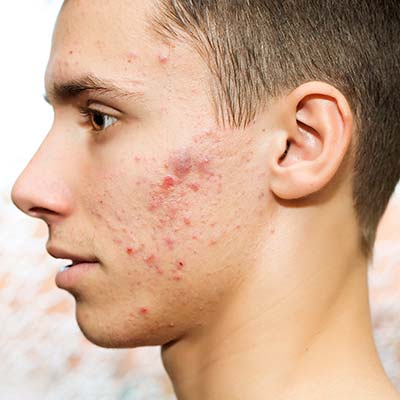About acne
Acne is a common skin condition that causes pimples and cysts.
Pimples and cysts develop when skin pores get blocked by dead skin cells and an oily substance called sebum. Bacteria can build up in the blocked pores and cause inflammation.
There are a few things that can make you more likely to get acne or make acne worse if you have it:
- puberty – hormonal changes in puberty cause the production of more sebum
- genetics – acne tends to run in families
- oily skin
- some oil-based or thick cosmetics, hair oils and hair grease
- stress.
Acne signs and symptoms
Acne most commonly develops on the face, neck, chest, upper back and upper arms.
Acne can range from small pimples to large cysts.
There are many types of pimples.
Non-inflamed pimples include the following:
- Whiteheads – these look like flesh-coloured bumps on the skin.
- Blackheads – these look like black bumps or large black pores on the skin.
Inflamed pimples include the following:
- Papules – these look like red, swollen bumps on light skin or brown, purple or grey swollen bumps on dark skin.
- Pustules – these are similar to papules but they’re filled with pus.
Cysts look like large bumps under the skin. They are filled with fluid, pus or other substances. They can be painful.
Acne can be mild, moderate or severe. It depends on the number of pimples or cysts you have, the size of the pimples or cysts, and the type.

Medical help: when to get it for children with acne
Your child should see a GP if:
- They have mild acne, and it hasn’t improved after 6-12 weeks of using the treatment described below.
- They have moderate to severe acne, painful cysts or scarring.
- Their acne is upsetting them, or they’re worried about the way it looks.
Your GP might refer you to a dermatologist.
Treatments for acne
Mild acne
If your child has mild acne, there are several things your child can do at home to improve their skin:
- Wash their face no more than twice a day using a gentle skin cleanser.
- Be gentle when face-washing. Hard scrubbing can make the acne worse.
- Apply a simple moisturiser that’s labelled ‘non-comedogenic’ after washing. This means it won’t clog pores.
- Try to leave the acne alone. Squeezing or picking pimples can lead to more inflammation and make the acne worse. It can also cause scarring.
Your child can also try over-the-counter acne treatments like salicylic acid or benzoyl peroxide to unclog the pores. It’s best to speak to a pharmacist before trying these treatments because they can lead to skin dryness or irritation.
Moderate or severe acne
Your GP or dermatologist might suggest:
- acne treatments like salicylic acid or benzoyl peroxide in stronger doses
- retinoid creams
- antibiotic tablets to help with controlling skin inflammation
- retinoid tablets (isotretinoin) – these tablets can have side effects, so talk with your doctor about whether they’re right for your child.
Your child should still wash their face. And they might still need a non-comedogenic moisturiser. It’s also best for your child to avoid make-up or to use products that are non-comedogenic.
For girls, medicine that targets the hormones that cause acne is another option. This includes the oral contraceptive pill and spironolactone. These medicines have side effects, so it’s a good idea to talk about these with your doctor.
Acne bumps take around 8 weeks to heal completely. Changes in skin colour can last for a couple of months, but this usually fades with time. Sometimes scarring is permanent.
Acne prevention
To prevent acne, it’s best to use non-comedogenic skin and hair products.
It can also help to wash your child’s pillowcases 1-2 times a week, especially if they use hair products.
If your child notices their acne gets worse when they eat certain foods, it might be a good idea to avoid those foods.
The effect of diet on acne is still being studied. It’s thought that a well-balanced diet can help with controlling acne. High-GI foods and too many dairy products can potentially make acne worse, because of their effect on hormones.